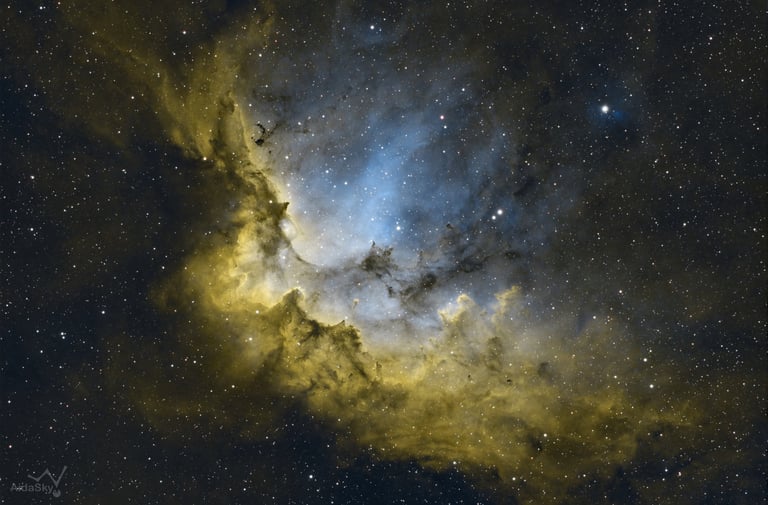

NGC7380
Telescope: Celestron EdgeHD 9.25
Mount: SWCQ350 Pro
Camera: ZWO ASI2600MC Pro
Filter: Antlia ALP-T Dual Band 5nm
Software: PixInsight
Acquisition: 135x300s frames, 11h 15'
Date: 2025.09.21; 23
Ūkas NGC 7380, dar vadinamas „Burtininko ūku“ (Wizard Nebula), yra emisinis ūkas Cefejo žvaigždyne, susijęs su jauna atvira žvaigždžių spiečiaus grupe.
Atradimo istorija
1787 m. rugpjūčio 7 d. jį atrado vokiečių–britų astronomas William Herschel.
Herschelis, naudodamas savo teleskopą, aprašė jį kaip žvaigždžių sankaupą, įterptą į rūko debesį. Tais laikais jis dažnai ieškojo naujų „rūko objektų“ (nebulae) ir žvaigždžių spiečių.
Vėliau objektą į Naujajį bendrąjį katalogą (NGC) įtraukė J. L. E. Dreyer 1888 m., suteikdamas jam numerį NGC 7380.
Įdomūs faktai
Tai yra atviras spiečius (žvaigždžių grupė), apsuptas emisiniu ūku.
Atstumas nuo Žemės – apie 7 200 šviesmečių.
„Burtininko ūkas“ pavadinimas prigijo dėl išskirtinės dujų ir dulkių formos, primenančios paslaptingo mago siluetą.
Bendri duomenys
Tipas: Atviras žvaigždžių spiečius su emisiniu ūku.
Žvaigždynas: Kefeus (Cepheus).
Atstumas: ~7 200 šviesmečių (apie 2,2 kiloparsekai).
Skersmuo: ~100 šviesmečių.
Matomas dydis: apie 25 lankų minutės (panašiai kaip Mėnulio disko dydis danguje).
Ryškis: ~7,2 magnitudės (spiečius), todėl matomas tik su teleskopu.
Struktūra
Žvaigždžių spiečius (NGC 7380): labai jaunas, jo amžius apie 4–5 mln. metų. Tai reiškia, kad jis dar formuojasi, o spiečiuje yra karštų, masyvių O ir B tipo žvaigždžių.
Ūkas (Sh2-142): spiečių supa emisinis ūkas, kuriame vandenilio dujos švyti dėl jonizacijos nuo jaunų žvaigždžių spinduliuotės.
Forma: dujų debesys primena žmogaus figūrą su „burtininko“ kepure, todėl prigijo pavadinimas „Wizard Nebula“.
Stebėjimai
Mėgėjų astronomams: ūkas yra gana silpnas, todėl geriausiai matomas naudojant vidutinio ar didelio skersmens teleskopus ir siaurajuosčius filtrus (Hα, OIII).
Fotografijoje: dėl savo sudėtingos formos ir spalvų (raudoni vandenilio spindėjimai, žalsvi deguonies ruožai) tai yra vienas populiariausių astrofotografijos objektų.
Įdomybės
Dujų debesyse vyksta aktyvi žvaigždėdaros veikla, todėl astronomai tiria šią sritį, kad suprastų, kaip formuojasi žvaigždės ir planetų sistemos.
Pats spiečius NGC 7380 (žvaigždės) ir ūkas Sh2-142 (dujų debesys) kartais painiojami – dažnai „NGC 7380“ pavadinimu vadinama visa struktūra, nors techniškai kataloge jis žymi tik spiečių.
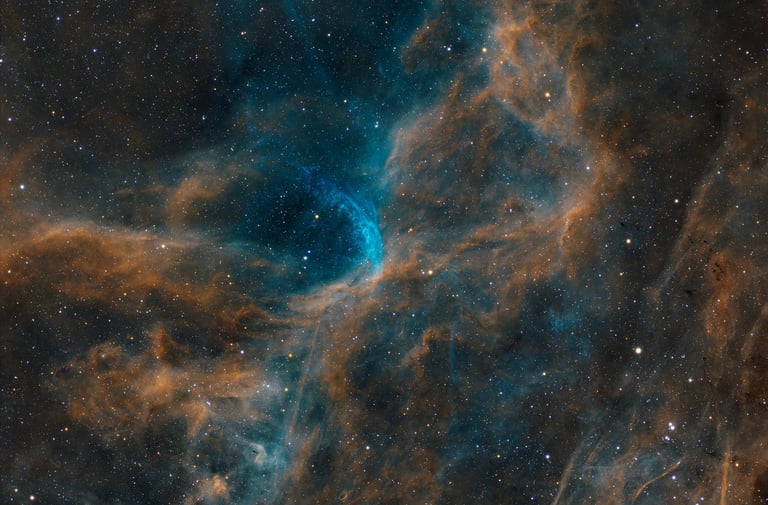

WR134
Telescope: Askar FRA500
Mount: iOptron Cem70
Camera: PlayerOne Poseidon M Pro
Filter: Antlia 3nm SHO
Software: PixInsight
Acquisition: 390x300s frames, 32h 30'
Date: 2025.08.04-28
WR 134 yra įdomi Wolf-Rayet tipo žvaigždė Cygnus (Gulbės) žvaigždyne, turinti daug neįprastų savybių. Štai ką apie ją žinoma:
Bendri duomenys
Katalogo pavadinimas: WR 134, kartais vadinama V1769 Cygni.
Atstumas iki Žemės: maždaug 6 000 šviesmečių (apie 1 800 parsekų).
Ryškumas (apparent magnitude): apie 8,08 – tai reiškia, kad plika akimi jos nepamatysi, bet su binokliu ar mažesniu teleskopu ‒ įmanoma.
Fizikinės charakteristikos
Spektrinis tipas: WN6-s – ji priklauso „azoto“ (nitrogen) sekai Wolf-Rayet žvaigždžių grupėje.
Paviršiaus temperatūra: ~63 000 K. Tai labai karšta žvaigždė.
Spindulys: maždaug 5,29 karto didesnis už Saulės spindulį.
Masė: apie 19 kartų Saulės masės.
Ryškumas (luminsoity): ~400 000 Saulės šviesos išspinduliavimų (bolometrinės ryškumo atžvilgiu).
Masės netekimas, vėjai, evoliucija
WR 134 intensyviai praranda masę per stiprius žvaigždės vėjus („stellar winds“). Vienas iš nurodytų duomenų – ~ 4×10⁻⁵ Saulės masės per metus.
Vėjo greitis: ~ 1820 km/s.
Tai reiškia, kad žvaigždė greitai netenka išorinių sluoksnių – tokia būklė yra vienas iš paskutinių etapų labai masyvių žvaigždžių gyvenime prieš jai užsibaigiant supernova.
Variacijos ir elgsena
WR 134 rodo spektroskopines ir fotometrines variacijas. Viena iš reikšmingų yra ~ 2,25 dienų periodas spektro linijų profilių pokyčiuose (pvz., He II emisijų linijoje).
Dar aiškiau, tai gali būti susiję su rotacine moduliacija arba galbūt su tam tikru antriniu objektu, nors tikslios priežastys nėra visiškai įrodytos.
Taip pat ji įtraukta į tyrimus apie „Co-rotating Interaction Regions“ (CIRs) — t. y. struktūras žvaigždės vėjyje, kurios sukasi kartu su žvaigžde, sukeldamos didesnį pokytį emisijos linijų profilyje.
Aplinkos efektai: nebula, burbulai
Apie WR 134 susiformavusi silpna, plona nebulos ar burbuolo struktūra (angl. bubble nebula) – tai dujų ir plazmos burbulas, suformuotas, kai žvaigždės vėjas stumia aplink esančias tarpgalaktines dujas.
Ši struktūra ypač matoma OIII (doubly ionized oxygen) linijų spindesiu – suteikia mėlynai-žalią atspalvį.
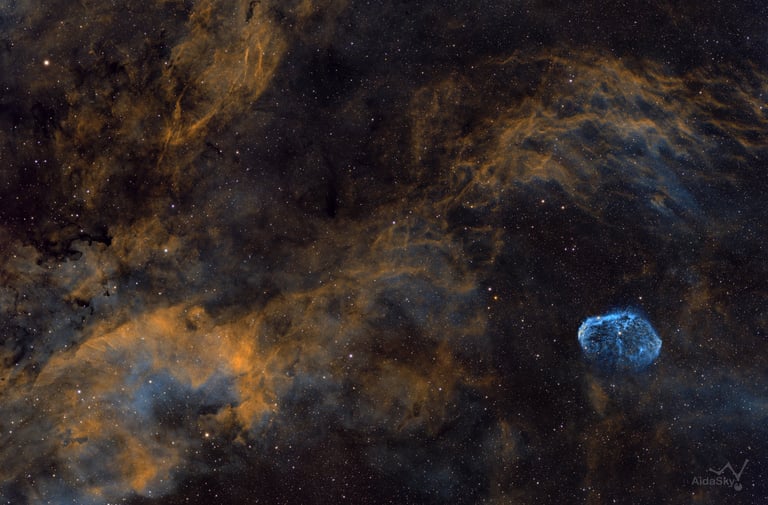

NGC6888 region
Telescope: Askar FRA500
Mount: iOptron Cem70
Camera: PlayerOne Poseidon M Pro
Filter: Antlia 3nm SHO
Software: PixInsight
Acquisition: 155x120s frames, 5h 30'
Date: 2025.06.19-23
Pusmėnulio ūkas NGC 6888, esantis Gulbės žvaigždyne, yra vienas iš įspūdingiausių ir žinomiausių astronominių objektų mūsų galaktikoje. Šis ūkas, dar žinomas kaip "Crescent Nebula", yra ryškus pavyzdys, kaip žvaigždžių gyvavimo ciklas įtakoja jų aplinką, sukuriant nuostabius ir dažnai sudėtingus dangaus reiškinius. NGC 6888 yra apie 5 000 šviesmečių atstumu nuo Žemės ir šiuo metu yra įsikūręs vietovėje, kurioje klesti vandenilio ir deguonies dujos. Šios dujos yra esminė sudedamoji dalis formuojant ūkus ir taip pat įrodo žvaigždžių evoliucijos procesus. Įdomu tai, kad Pusmėnulio ūkas kilęs iš stipriai išsiplėtusios žvaigždės, kuri pasiekė savo gyvenimo pabaigą. Tai žvaigždė, žinoma kaip Wolf-Rayet žvaigždė, išskyrė didelį kiekį medžiagos, šios dujos suformavo ūką, kurį mes šiandien galime stebėti. Dėl didelio spinduliavimo ir aktyvios medžiagos išmetimo, NGC 6888 yra puikus taikinys astronomams, tyrinėjantiems žvaigždžių poveikį savo aplinkai. Vandenilio ir deguonies dujų emisija sukuria ryškius spalvinius atspalvius, kurie ypač gerai matomi naudojant Hubble kosminį teleskopą. Šios spalvos yra pagrįstos dujų temperatūromis ir energijos lygiais, o tai suteikia papildomos informacijos apie ūko sudėtį ir jo raidos procesus. Gulbės žvaigždynas, kuriame įsikūręs šis ūkas, taip pat yra žinomas dėl savo kitų žvaigždžių ir dangaus fenomenų, todėl jis traukia ne tik profesionalių astronomų, bet ir mėgėjų dėmesį. NGC 6888 yra vienas iš tų objektų, kurį lengva atpažinti, o jo unikali forma ir struktūra pritraukia didelį susidomėjimą. Tyrinėjant Pusmėnulio ūką, mokslininkai gali geriau suprasti, kaip žvaigždžių vėjai ir radiacija formuoja kosmoso struktūras. NGC 6888 yra puikus pavyzdys to, kas galėtų vykti visoje Visatoje, kai žvaigždės ir jų aplinka sąveikauja. Analizuojant šį objektą, galime gauti vertingų žinių apie šių procesų dinamiką ir jų įtaką galaktikos evoliucijai. Apskritai, pusmėnulio ūkas NGC 6888 nėra tik estetine prasme gražus fenomenas; jis taip pat atspindi sudėtingus ir įdomias kosmines istorijas. Kiekvienas stebėjimas šio objekto parodo ne tik jo unikalumą, bet ir didingą Visatos procesą, kuris vyksta net tolimiausiuose jos kampeliuose.
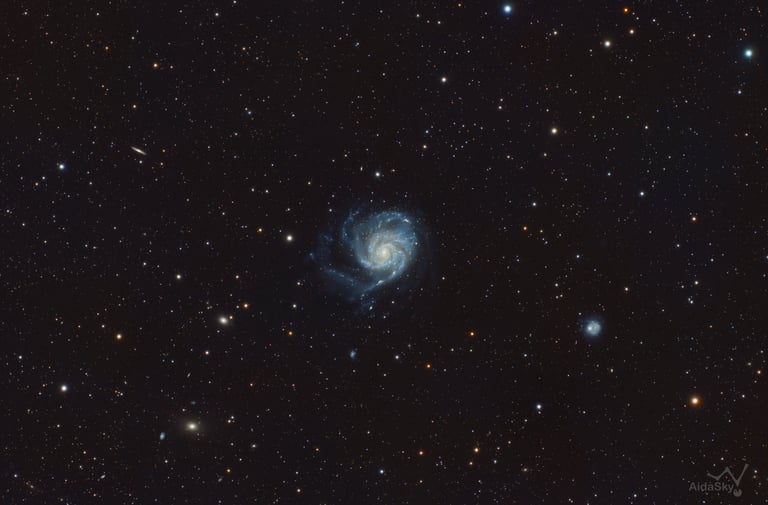

Messier 101 in wide
Telescope: Askar FRA500
Mount: iOptron Cem70
Camera: ZWO ASI2600MC Pro
Filter: Optolong L-Pro
Software: PixInsight
Acquisition: 361x180s frames, 18h 30'
Date: 2025.06.04-06
Messier 101, also known as the Pinwheel Galaxy, is a stunning spiral galaxy located in the constellation Ursa Major. It is renowned for its elaborate structure and rich details, which can be vividly observed in wide-field images. At the right of this captivating galaxy lies NGC 5474, a peculiar dwarf galaxy interacting gravitationally with Messier 101. This interaction manifests as a striking asymmetry in the spiral arms of Messier 101, creating a beautiful tapestry of stars, gas, and dust. The combined light from these two galaxies offers astronomers a unique opportunity to study the dynamics of galactic interactions and the formation of new stars. Observers often marvel at the visual splendor of this duo, which exemplifies the beauty and complexity of the universe.


Jellyfish Nebula (IC443/Sh2-248)
Telescope: ASKAR FRA500
Mount: iOptron CEM70
Camera: ZWO ASI2600MC Pro
Filter: Antlia ALP-T Dual band 5nm
Software: PixInsight
Acquisition: 84x300s frames, 7h 00'
Date: 2024.12.11
The Jellyfish Nebula, also known as IC 443 or Sh2-248, is a stunning supernova remnant located approximately 5,000 light-years away from Earth in the constellation Gemini. This fascinating cosmic structure is believed to be around 30,000 years old, originating from a massive star that ended its life in a brilliant explosion. The remnants of the supernova are characterized by their intricate filaments and vibrant colors, which result from the interaction between the expelled stellar material and the surrounding gas and dust. Its delicate structure resembles a jellyfish gliding through the cosmic ocean, making it a captivating feature of the night sky.
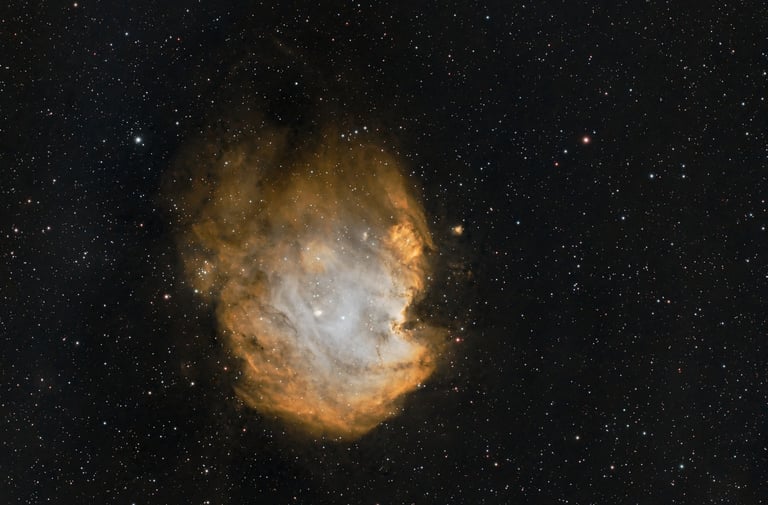

The Monkey Head Nebula, also known as NGC 2174, is a stunning emission nebula located in the Orion constellation. This vibrant cosmic region captures the imagination with its intricate structures and colorful gas clouds. Resembling the shape of a monkey's head, the nebula is a stellar nursery, where new stars are born amid the swirling dust and gas. Despite its beauty, it is often overshadowed by more famous astronomical landmarks. The Monkey Head Nebula lies approximately 6,400 light-years away from Earth.
Monkey Head Nebula
Telescope: ASKAR FRA500
Mount: iOptron CEM70
Camera: ZWO ASI2600MC Pro
Filter: Antlia ALP-T Dual Band 5nm
Software: PixInsight
Acquisition: 83x300s frames, 6h 55'
Date: 2024.12.18
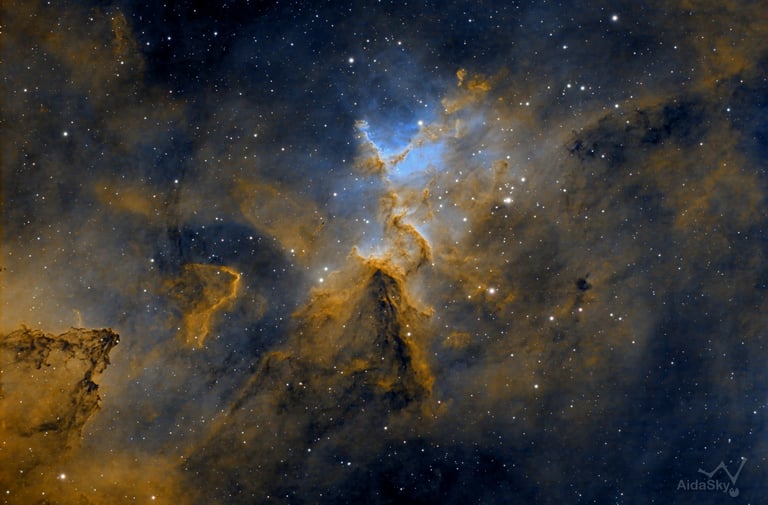

Melotte 15 (IC1805)
Telescope: Celestron EdgeHD 9.25
Mount: SW CQ350
Camera: ZWO ASI294MC Pro
Filter: Optolong L-Ultimate
Software: PixInsight
Acquisition: 89x300s frames, 7h 25'
Date: 2024.12.18-22
The Melotte 15, also known as the Heart Nebula, is a mesmerizing cluster of stars situated within the larger complex of the IC 1805 nebula, resembling the shape of a heart. This region is rich in star formation, showcasing the dynamic interplay of gas and dust that ignite new stellar births. Located approximately 7,500 light-years away in the constellation Cassiopeia, Melotte 15 is a captivating sight for astronomers and astrophotographers alike. The nebula’s luminous gas clouds are illuminated by the young, hot stars that have recently formed within it, creating a stunning tapestry of colors and light. Notably, it serves as an excellent example of how stellar nurseries operate, contributing valuable insight into the lifecycle of stars and the evolution of cosmic structures in our universe.
